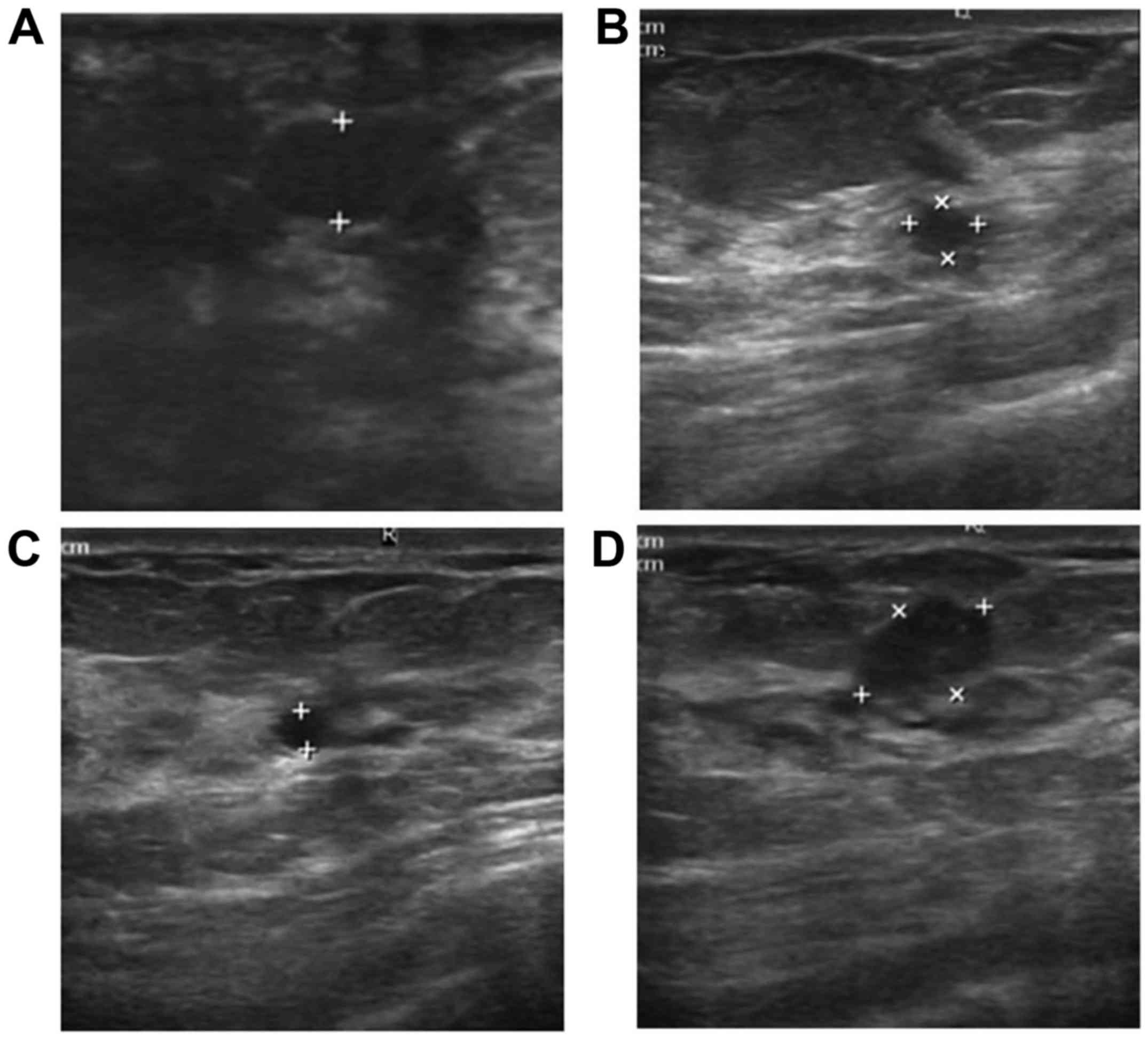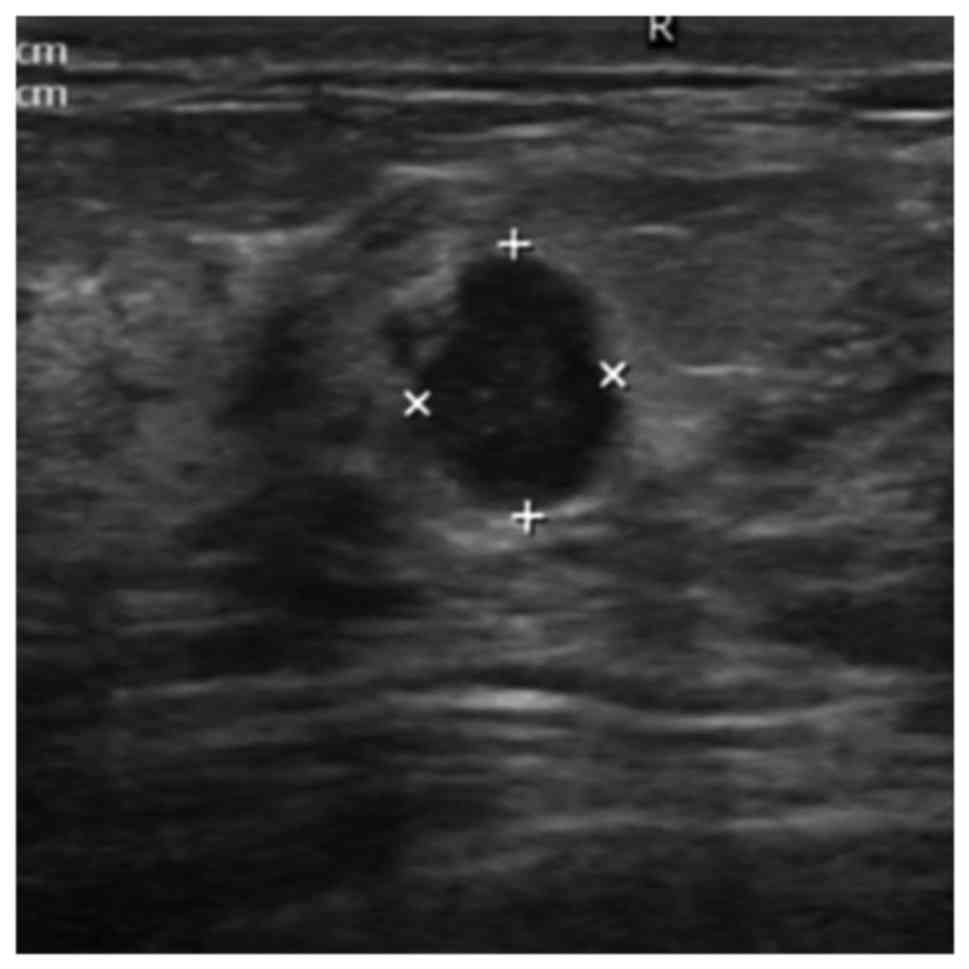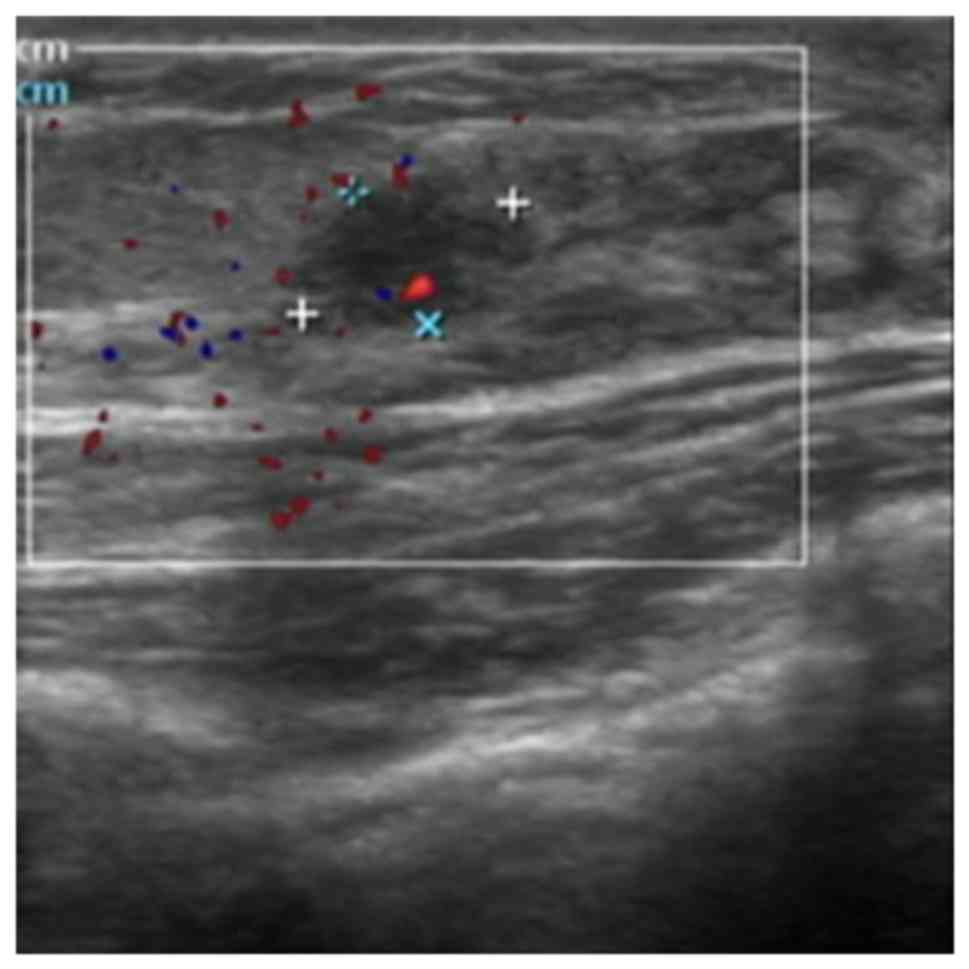|
1
|
Dundar MM, Badve S, Bilgin G, Raykar V,
Jain R, Sertel O and Gurcan MN: Computerized classification of
intraductal breast lesions using histopathological images. IEEE
Trans Biomed Eng. 58:1977–1984. 2011.PubMed/NCBI View Article : Google Scholar
|
|
2
|
Yang L, Wu D and Fan ZM: Retrospective
analysis of pathologic nipple discharge. Genet Mol Res.
14:1443–1449. 2015.PubMed/NCBI View Article : Google Scholar
|
|
3
|
Han Y, Li J, Han S, Jia S, Zhang Y and
Zhang W: Diagnostic value of endoscopic appearance during
ductoscopy in patients with pathological nipple discharge. BMC
Cancer. 17(300)2017.PubMed/NCBI View Article : Google Scholar
|
|
4
|
Lang JE and Kuerer HM: Breast ductal
secretions: Clinical features, potential uses, and possible
applications. Cancer Control. 14:350–359. 2007.PubMed/NCBI View Article : Google Scholar
|
|
5
|
Escobar PF, Crowe JP, Matsunaga T and
Mokbel K: The clinical applications of mammary ductoscopy. Am J
Surg. 191:211–215. 2006.PubMed/NCBI View Article : Google Scholar
|
|
6
|
Montroni I, Santini D, Zucchini G, Fiacchi
M, Zanotti S, Ugolini G, Manaresi A and Taffurelli M: Nipple
discharge: Is its significance as a risk factor for breast cancer
fully understood? Observational study including 915 consecutive
patients who underwent selective duct excision. Breast Cancer Res
Treat. 123:895–900. 2010.PubMed/NCBI View Article : Google Scholar
|
|
7
|
Maxwell AJ, Mataka G and Pearson JM:
Benign papilloma diagnosed on image-guided 14 G core biopsy of the
breast: Effect of lesion type on likelihood of malignancy at
excision. Clin Radiol. 68:383–387. 2013.PubMed/NCBI View Article : Google Scholar
|
|
8
|
Sparks CA: Using ductoscopy to detect
breast mass at an early stage. AORN J. 76:851–854. 2002.PubMed/NCBI View Article : Google Scholar
|
|
9
|
Dubowy A, Raubach M, Topalidis T, Lange T,
Eulenstein S and Hünerbein M: Breast duct endoscopy: Ductoscopy
from a diagnostic to an interventional procedure and its future
perspective. Acta Chir Belg. 111:142–145. 2011.PubMed/NCBI View Article : Google Scholar
|
|
10
|
Shiino S, Tsuda H, Yoshida M, Jimbo K,
Asaga S, Hojo T and Kinoshita T: Intraductal papillomas on core
biopsy can be upgraded to malignancy on subsequent excisional
biopsy regardless of the presence of atypical features. Pathol Int.
65:293–300. 2015.PubMed/NCBI View Article : Google Scholar
|
|
11
|
Swapp RE, Glazebrook KN, Jones KN, Brandts
HM, Reynolds C, Visscher DW and Hieken TJ: Management of benign
intraductal solitary papilloma diagnosed on core needle biopsy. Ann
Surg Oncol. 20:1900–1905. 2013.PubMed/NCBI View Article : Google Scholar
|
|
12
|
Li X, Weaver O, Desouki MM, Dabbs D, Shyum
S, Carter G and Zhao C: Microcalcification is an important factor
in the management of breast intraductal papillomas diagnosed on
core biopsy. Am J Clin Pathol. 138:789–795. 2012.PubMed/NCBI View Article : Google Scholar
|
|
13
|
Chang JM, Moon WK, Cho N, Han W, Noh DY,
Park IA and Jung EJ: Risk of carcinoma after subsequent excision of
benign papilloma initially diagnosed with an ultrasound (US)-guided
14-gauge core needle biopsy: A prospective observational study. Eur
Radiol. 20:1093–1100. 2010.PubMed/NCBI View Article : Google Scholar
|
|
14
|
Sakr R, Rouzier R, Salem C, Antoine M,
Chopier J, Darai E and Uzan S: Risk of breast cancer associated
with papilloma. Eur J Surg Oncol. 34:1304–1308. 2008.PubMed/NCBI View Article : Google Scholar
|
|
15
|
Fatemi Y, Hurley R, Grant C, Henrichsen T,
Chen B and Ghosh K: Challenges in the management of giant
intraductal breast papilloma. Clin Case Rep. 3:7–10.
2015.PubMed/NCBI View
Article : Google Scholar
|
|
16
|
Sydnor MK, Wilson JD, Hijaz TA, Massey HD
and Shaw de Paredes ES: Underestimation of the presence of breast
carcinoma in papillary lesions initially diagnosed at core-needle
biopsy. Radiology. 242:58–62. 2007.PubMed/NCBI View Article : Google Scholar
|
|
17
|
Yi W, Xu F, Zou Q and Tang Z: Completely
removing solitary intraductal papillomas using the mammotome system
guided by ultrasonography is feasible and safe. World J Surg.
37:2613–2617. 2013.PubMed/NCBI View Article : Google Scholar
|
|
18
|
Mosier AD, Keylock J and Smith DV: Benign
papillomas diagnosed on large-gauge vacuum-assisted core needle
biopsy which span <1.5 cm do not need surgical excision. Breast
J. 19:611–617. 2013.PubMed/NCBI View Article : Google Scholar
|
|
19
|
Ward EM, DeSantis CE, Lin CC, Kramer JL,
Jemal A, Kohler B, Brawley OW and Gansler T: Cancer statistics:
Breast cancer in situ. CA Cancer J Clin. 65:481–495.
2015.PubMed/NCBI View Article : Google Scholar
|
|
20
|
Foote FW and Stewart FW: Lobular carcinoma
in situ: A rare form of mammary cancer. Am J Pathol. 17:491–496.3.
1941.PubMed/NCBI View Article : Google Scholar
|
|
21
|
Wen HY and Brogi E: Lobular carcinoma in
situ. Surg Pathol Clin. 11:123–145. 2018.PubMed/NCBI View Article : Google Scholar
|
|
22
|
Yang WT and Zhu XZ: The introduction of
2012 WHO classification of tumours of the breast. Zhonghua Bing Li
Xue Za Zhi. 42:78–80. 2013.(In Chinese). PubMed/NCBI View Article : Google Scholar
|
|
23
|
Zhu Y, Zhang S, Liu P, Lu H, Xu Y and Yang
WT: Solitary intraductal papillomas of the breast: MRI features and
differentiation from small invasive ductal carcinomas. AJR Am J
Roentgenol. 199:936–942. 2012.PubMed/NCBI View Article : Google Scholar
|
|
24
|
Wang LC, DeMartini WB, Partridge SC,
Peacock S and Lehman CD: MRI-detected suspicious breast lesions:
Predictive values of kinetic features measured by computer-aided
evaluation. AJR Am J Roentgenol. 193:826–831. 2009.PubMed/NCBI View Article : Google Scholar
|
|
25
|
Jung SY, Kang HS, Kwon Y, Min SY, Kim EA,
Ko KL, Lee S and Kim SW: Risk factors for malignancy in benign
papillomas of the breast on core needle biopsy. World J Surg.
34:261–265. 2010.PubMed/NCBI View Article : Google Scholar
|
|
26
|
Lewis JT, Hartmann LC, Vierkant RA,
Maloney SD, Shane Pankratz V, Allers TM, Frost MH and Visscher DW:
An analysis of breast cancer risk in women with single, multiple,
and atypical papilloma. Am J Surg Pathol. 30:665–672.
2006.PubMed/NCBI View Article : Google Scholar
|
|
27
|
Page DL, Salhany KE, Jensen RA and Dupont
WD: Subsequent breast carcinoma risk after biopsy with atypia in a
breast papilloma. Cancer. 78:258–266. 1996.PubMed/NCBI View Article : Google Scholar
|
|
28
|
Glenn ME, Throckmorton AD, Thomison JB III
and Bienkowski RS: Papillomas of the breast 15 mm or smaller:
4-Year experience in a community-based dedicated breast imaging
clinic. Ann Surg Oncol. 22:1133–1139. 2015.PubMed/NCBI View Article : Google Scholar
|
|
29
|
Pareja F, Corben AD, Brennan SB, Murray
MP, Bowser ZL, Jakate K, Sebastiano C, Morrow M, Morris EA and
Brogi E: Breast intraductal papillomas without atypia in
radiologic-pathologic concordant core-needle biopsies: Rate of
upgrade to carcinoma at excision. Cancer. 122:2819–2827.
2016.PubMed/NCBI View Article : Google Scholar
|
|
30
|
Chang JM, Moon WK, Cho N, Han W, Noh DY,
Park IA and Jung EJ: Management of ultrasonographically detected
benign papillomas of the breast at core needle biopsy. AJR Am J
Roentgenol. 196:723–729. 2011.PubMed/NCBI View Article : Google Scholar
|
|
31
|
Rizzo M, Linebarger J, Lowe MC, Pan L,
Gabram SG, Vasquez L, Cohen MA and Mosunjac M: Management of
papillary breast lesions diagnosed on core-needle biopsy: Clinical
pathologic and radiologic analysis of 276 cases with surgical
follow-up. J Am Coll Surg. 214:280–287. 2012.PubMed/NCBI View Article : Google Scholar
|
|
32
|
Suh JS, Yoo KY, Kwon OJ, Yun IJ, Han SH,
Noh DY and Choe KJ: Menstrual and reproductive factors related to
the risk of breast cancer in Korea. Ovarian hormone effect on
breast cancer. J Korean Med Sci. 11:501–508. 1996.PubMed/NCBI View Article : Google Scholar
|
|
33
|
Huang Y, Zhang X, Li W, Song F, Dai H,
Wang J, Gao Y, Liu X, Chen C, Yan Y, et al: A meta-analysis of the
association between induced abortion and breast cancer risk among
Chinese females. Cancer Causes Control. 25:227–236. 2014.PubMed/NCBI View Article : Google Scholar
|
|
34
|
Arthur R, Wang Y, Ye K, Glass AG, Ginsberg
M, Loudig O and Rohan T: Association between lifestyle,
menstrual/reproductive history, and histological factors and risk
of breast cancer in women biopsied for benign breast disease.
Breast Cancer Res Treat. 165:623–631. 2017.PubMed/NCBI View Article : Google Scholar
|
|
35
|
Jung S, Egleston BL, Chandler DW, Van Horn
L, Hylton NM, Klifa CC, Lasser NL, LeBlanc ES, Paris K, Shepherd
JA, et al: Adolescent endogenous sex hormones and breast density in
early adulthood. Breast Cancer Res. 17(77)2015.PubMed/NCBI View Article : Google Scholar
|
|
36
|
Noroozian M, Stein LF, Gaetke-Udager K and
Helvie MA: Long-term clinical outcomes in women with breast pain in
the absence of additional clinical findings: Mammography remains
indicated. Breast Cancer Res Treat. 149:417–424. 2015.PubMed/NCBI View Article : Google Scholar
|
|
37
|
Preece PE, Baum M, Mansel RE, Webster DJ,
Fortt RW, Gravelle IH and Hughes LE: Importance of mastalgia in
operable breast cancer. Br Med J (Clin Res Ed). 284:1299–1300.
1982.PubMed/NCBI View Article : Google Scholar
|
|
38
|
Hsu HH, Yu JC, Hsu GC, Chang WC, Yu CP,
Tung HJ, Tzao C and Huang GS: Ultrasonographic alterations
associated with the dilatation of mammary ducts: Feature analysis
and BI-RADS assessment. Eur Radiol. 20:293–302. 2010.PubMed/NCBI View Article : Google Scholar
|
|
39
|
Francis A, England D, Rowlands D and
Bradley S: Breast papilloma: Mammogram, ultrasound and MRI
appearances. Breast. 11:394–397. 2002.PubMed/NCBI View Article : Google Scholar
|
|
40
|
Zhu QL, Zhang J, Lai XJ, Wang HY, Xiao MS
and Jiang YX: Characterisation of breast papillary neoplasm on
automated breast ultrasound. Br J Radiol.
86(20130215)2013.PubMed/NCBI View Article : Google Scholar
|
|
41
|
Chang JM, Han W, Moon WK, Cho N, Noh DY,
Park IA and Jung EJ: Papillary lesions initially diagnosed at
ultrasound-guided vacuum-assisted breast biopsy: Rate of malignancy
based on subsequent surgical excision. Ann Surg Oncol.
18:2506–2514. 2011.PubMed/NCBI View Article : Google Scholar
|

















